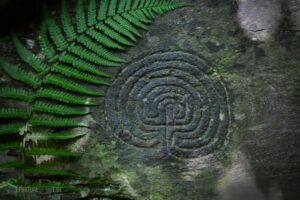What is the spiritual meaning of palm sunday? Triumph!
Palm Sunday marks the start of Holy Week and commemorates Jesus Christ’s triumphant entry into Jerusalem.
Spiritually, it signifies the humbleness of Jesus and the fulfillment of prophesies in the Bible. It is a celebration of hope, victory, and the anticipation of Jesus’s resurrection.
Palm Sunday gets its name from the palm branches that were spread on the road as Jesus rode into Jerusalem on a donkey.
Biblically, this act was seen as a sign of honor and respect. In a spiritual context, Palm Sunday represents the triumph of good over evil, as Jesus entered the city knowing he would be tried, crucified, and resurrected.
In many parts of the world, Palm Sunday continues to be observed with processions, distribution of palm leaves, and special church services.
This day reminds Christians everywhere of Jesus’s willingness to sacrifice himself for mankind, highlighting core values of humility, sacrifice, and victory over evil.
7 Aspects: Spiritual Meaning Of Palm Sunday
| Aspect | Spiritual Meaning |
|---|---|
| Entry into Jerusalem | Palm Sunday commemorates Jesus’ triumphant entry into Jerusalem, where people laid down palm branches in his path, symbolizing victory and royalty. This event signifies the beginning of the Holy Week leading to Jesus’ crucifixion and resurrection. |
| Palm Branches | The palm branches used on Palm Sunday represent peace, victory, and the fulfillment of prophecy (Zechariah 9:9). They also signify the recognition of Jesus as the Messiah and King of Israel. |
| Humility | Jesus’ choice to ride on a donkey instead of a horse signifies his humility and desire to enter the city as a servant, not as a conquering king. This teaches the importance of humility in the spiritual journey. |
| Fulfillment of Prophecy | Palm Sunday fulfills the Old Testament prophecy in Zechariah 9:9, where the Messiah is described as entering Jerusalem riding a donkey. This event highlights the divine plan and the role of Jesus as the Messiah. |
| Preparation for the Passion | Palm Sunday marks the beginning of the Holy Week, during which Jesus’ passion, death, and resurrection are commemorated. It serves as a reminder of the challenging path Jesus took to save humanity and invites believers to reflect on their own spiritual journey. |
| Celebration and Sorrow | While Palm Sunday is a celebration of Jesus’ arrival in Jerusalem, it also foreshadows the suffering and death he would experience later in the week. This duality serves as a reminder of the joy and sorrow that can be found in the spiritual life. |
| Faith and Commitment | Palm Sunday invites believers to recognize Jesus as their Savior and renew their commitment to follow him, even in the face of challenges and suffering. This event is a call for Christians to deepen their faith and trust in God. |
Key Takeaway

Five Facts About: Palm Sunday
The Historical Roots Of Palm Sunday
Palm sunday holds great significance in the christian faith as it commemorates jesus’s triumphal entry into jerusalem, just days before his crucifixion.
This joyous event is steeped in historical and spiritual meaning, reflecting the fulfillment of prophecies and messianic expectations.
Join us as we explore the roots of palm sunday and uncover the profound spiritual significance it holds.
Jesus’S Triumphal Entry Into Jerusalem
- After spending years ministering to the people, jesus chose this moment to openly declare his messiahship and fulfill ancient prophecies.
- Riding on a donkey, a symbol of humility and peace, jesus entered jerusalem amidst the excitement and adoration of the crowds.
- The people, aware of jesus’s miracles and teachings, laid their garments and palm branches on the road, welcoming him as the long-awaited messiah.
Fulfilling Prophecy And Messianic Expectations
- The triumphal entry aligns with old testament prophecies, particularly zechariah 9: 9, which foretold the messiah’s arrival on a donkey.
- By deliberately fulfilling these prophecies, jesus affirmed his identity as the promised savior in the eyes of those who recognized the significance.
- This triumphant arrival fuelled people’s hopes, as they associated jesus with the liberation of the jewish nation from roman oppression.
The Spiritual Significance Of Palm Sunday
- Palm sunday symbolizes the beginning of holy week, leading up to easter sunday, where christians commemorate jesus’s death and resurrection.
- It serves as a reminder of jesus’s unwavering commitment to fulfill god’s plan for the salvation of humanity, even amidst imminent suffering.
- The palm branches, a symbol of victory, regality, and peace, represent jesus as the ultimate conqueror and bringer of peace through his sacrifice.
Embracing The Message Of Palm Sunday
- Palm sunday offers us an opportunity for personal reflection and spiritual growth by reminding us of jesus’s selflessness and unwavering dedication.
- It encourages us to examine our own lives, to be humble, and to surrender to god’s will, just as jesus humbly rode into jerusalem.
- Palm sunday calls us to embrace jesus’s message of love, forgiveness, and redemption, employing these virtues in our daily lives.
Let us dive deeper into the spiritual significance and practices associated with palm sunday, as we prepare our hearts for the holy season of easter.
Symbolism And Rituals Of Palm Sunday
Palm sunday is a significant day in the christian calendar that commemorates jesus christ’s triumphant entry into jerusalem before his crucifixion.
Beyond its historical context, palm sunday holds deep spiritual meaning and is celebrated with various symbols and rituals.
Let’s explore two key aspects of palm sunday’s symbolism and rituals: palms as a symbol of victory and triumph, and the spreading of palms as a gesture of welcome.
Palms As A Symbol Of Victory And Triumph
- Palm branches have long been associated with victory and triumph across different cultures and religions.
- In biblical times, palms were often used to symbolize joy, triumph, and the presence of divinity.
- On palm sunday, worshipers carry or wave palms to honor jesus’ arrival in jerusalem and to signify their belief in his triumph over sin and death.
- The use of palms on this day reinforces the spiritual significance of jesus’ journey and his ultimate victory over the forces of darkness.
- The palm branches are also a reminder of the laying down of clothes and branches by the crowd as jesus entered jerusalem, a sign of adoration and respect.
The Spreading Of Palms As A Gesture Of Welcome
- In addition to symbolizing victory, the spreading of palms on palm sunday carries a gesture of welcome.
- The act of spreading palms in the path of jesus reflects the people’s recognition and acceptance of him as the messiah.
- By placing palms on the ground, people expressed their enthusiastic welcome, acknowledging jesus’ rightful place in their lives.
- This ritual signifies the individual and collective invitation for jesus to enter their hearts, homes, and communities.
- The spreading of palms serves as a powerful reminder to embrace jesus’ teachings of love, compassion, and forgiveness.
- By laying palms as a gesture of welcome, believers demonstrate their desire to follow in his footsteps and invite him to guide their lives.
Remember, as we observe palm sunday, let us not only participate in the rituals but also consider the profound symbolism behind them. Palms represent victory and triumph, while the spreading of palms symbolizes a gesture of welcome to jesus.
May the significance of these symbols deepen our faith and inspire us to live according to jesus’ teachings.
The Spiritual Lessons Of Palm Sunday
On palm sunday, christians around the world commemorate the triumphal entry of jesus into jerusalem, shortly before his crucifixion and resurrection.
Beyond the festive scene of palm branches and praises, there are profound spiritual lessons that can be gleaned from this event.
Here are two key insights we can draw from palm sunday:
Humility And Servanthood As Exemplified By Jesus
- Jesus, being fully aware of his divinity, chose to enter jerusalem riding on a humble donkey, a significant symbol of servanthood.
- This act showcased jesus’ profound humility, as he demonstrated that true leadership lies in serving others rather than seeking personal glory.
- By following jesus’ example, christians are called to humble themselves, embracing a servant-hearted attitude towards others.
- True greatness is not measured by status or possessions, but by the love and care we show to those around us.
- As we reflect on palm sunday, it reminds us of the power of humility and the transformative impact it can have on our lives and communities.
Surrendering To God’S Will And Purpose
- Palm sunday marks the beginning of jesus’ journey towards the ultimate sacrifice of his life on the cross, in accordance with god’s divine plan.
- In the garden of gethsemane, jesus prayed, “father, if you are willing, take this cup from me; yet not my will, but yours be done.”
- His surrender to god’s will exemplifies a deep trust and obedience to god’s purpose, even in the face of great suffering.
- Similarly, we are called to surrender our own plans and desires to align with god’s will for our lives.
- Through surrender, we find peace, strength, and the fulfillment of our true purpose.
- Palm sunday serves as a reminder of the importance of yielding ourselves to god, trusting in his guidance and embracing his plans for us.
As we contemplate the spiritual meaning of palm sunday, let us strive to cultivate humility in our lives and surrender ourselves to god’s will, finding fulfillment in serving others and embracing his purpose for us.
May this powerful day of remembrance inspire us to live with unwavering faith and devotion, following the footsteps of jesus christ.
Palm Sunday In Christian Tradition
Palm sunday is an important day in the christian calendar that holds significant spiritual meaning. This day commemorates the triumphal entry of jesus christ into jerusalem, just days before his crucifixion.
Christians around the world celebrate palm sunday with various liturgical celebrations and processions.
Let’s take a closer look at these practices.
Liturgical Celebrations And Processions
Palm sunday is marked by special liturgical celebrations and processions that symbolize jesus’ entry into Jerusalem.
Here are the key points to understand about these traditions:
- Blessing of palms: At the beginning of the service, palm branches are blessed by the priest or minister. These branches represent the palm leaves that the people of jerusalem laid before jesus as he entered the city.
- Distribution of palms: Following the blessing, the blessed palm branches are distributed to the congregation. People typically hold them during the processions and carry them home as a symbol of their participation in the celebration.
- Processions: Processions are a central part of palm sunday celebrations. Church members and clergy process into the church, often singing hymns and waving palm branches. This reenacts jesus’ entry into jerusalem, where he was greeted with palm branches and shouts of “hosanna!”
- Remembrance of the passion: Palm sunday also serves as a reminder of the passion and death of jesus christ. During the liturgy, there may be readings or reenactments of the events leading up to jesus’ crucifixion, including the last supper and the washing of the feet.
- Reading of the gospel: The gospel accounts of jesus’ triumphal entry into jerusalem are read during the palm sunday liturgy. This helps to create a connection between the biblical event and the present-day celebration.
- Symbolic gestures: Throughout the service, various symbolic gestures are performed, such as bowing or genuflecting as an act of reverence. These gestures add depth and meaning to the palm sunday experience.
As christians gather on palm sunday, they not only commemorate jesus’ entry into jerusalem but also reflect on the sacrifice he made for humanity. The liturgical celebrations and processions provide a tangible way for believers to connect with this significant event in the christian tradition.
Remember, palm sunday is just the beginning of holy week, which leads up to easter sunday. The events of palm sunday set the stage for the solemnity and joy of easter, making it an integral part of the christian faith.
Keep your palm branches handy as we continue our journey through holy week and delve into the spiritual significance of each day leading up to easter sunday.
The Relevance Of Palm Sunday In Today’S World
Palm sunday, a significant event in the christian calendar, continues to hold great relevance in today’s world. This solemn occasion commemorates jesus’ triumphal entry into jerusalem, where he was greeted with cheers and the waving of palm branches.
As we reflect on the spiritual meaning of palm sunday, we discover its relevance in our modern lives.
Reflecting On Our Relationship With God
On palm sunday, we are reminded of the importance of nurturing and deepening our relationship with god.
Through reflection and contemplation, we can:
- Seek forgiveness and renewal: Palm sunday serves as a reminder for us to reflect on our actions and seek forgiveness for our shortcomings. By acknowledging our mistakes and asking for god’s mercy, we can experience spiritual growth and renewal.
- Express gratitude for god’s blessings: This occasion prompts us to give thanks for the abundant blessings in our lives. By expressing gratitude, we cultivate a positive mindset and a deeper appreciation for the goodness that surrounds us.
- Open our hearts to god’s guidance: Palm sunday urges us to surrender our lives to god and trust in his divine guidance. By opening our hearts to his presence, we invite his love, wisdom, and direction to guide us through life’s challenges.
Drawing Strength To Face Challenges And Obstacles
In today’s world, where challenges and obstacles are a part of daily life, the symbolism of palm sunday offers us strength and encouragement.
Here’s how we can draw inspiration from this significant day:
- Finding hope amidst adversity: Just as jesus faced trials on palm sunday, we too encounter difficulties in our personal journeys. By emulating his strength and resilience, we find hope and courage to overcome obstacles.
- Embracing humility in times of success: Palm sunday reminds us to remain humble in times of success and triumph. In a world filled with competitiveness and self-promotion, embracing humility allows us to maintain balance and perspective in our achievements.
- Walking the path of compassion: The spirit of palm sunday calls us to extend love, compassion, and understanding to others. By embodying these virtues, we not only deepen our connection with god but also foster unity and harmony within our communities.
- Living a life of purpose: As we commemorate palm sunday, we are encouraged to reflect on our purpose and mission in life. By aligning our actions with our spiritual values, we find fulfillment and live a life that makes a positive impact on the world.
Through reflection on our relationship with god and drawing strength from the lessons of palm sunday, we can navigate the complexities of the modern world with faith, hope, and compassion.
May this significant occasion guide and inspire us to lead purposeful lives rooted in love and service to others.
FAQ On What Is The Spiritual Meaning Of Palm Sunday?
What Is The Significance Of Palm Sunday?
Palm sunday holds great significance in christian tradition as it commemorates jesus’ triumphant entry into jerusalem.
Why Do We Wave Palm Branches On Palm Sunday?
Waving palm branches on palm sunday symbolizes the path strewn with palms that jesus took during his entry into jerusalem.
What Is The Spiritual Meaning Behind Palms?
Palms symbolize victory, triumph, and peace. In christianity, they represent the triumph of jesus and the promise of eternal life.
How Is Palm Sunday Celebrated Around The World?
Palm sunday is celebrated worldwide with processions, the blessing of palms, and the reenactment of jesus’ entry into jerusalem.
Why Is It Called Palm Sunday?
It is called palm sunday because people waved palm branches to welcome and honor jesus as he entered jerusalem.
Conclusion
Palm sunday holds deep spiritual significance for christians around the world. It commemorates the triumphal entry of jesus into jerusalem, an event that symbolizes hope, salvation, and the fulfillment of prophecies.
This day marks the beginning of holy week, a time of reflection and preparation leading up to easter sunday.
As we wave palm branches and rejoice in jesus’ arrival, we are reminded of the great sacrifice he made for us on the cross. Palm sunday also serves as a reminder to remain steadfast in our faith, even in the face of challenges and adversity.
It is a time to renew our commitment to follow jesus and live according to his teachings. By embracing the spiritual meaning of palm sunday, we are able to connect with the profound message of love, redemption, and eternal life that lies at the heart of christianity.






